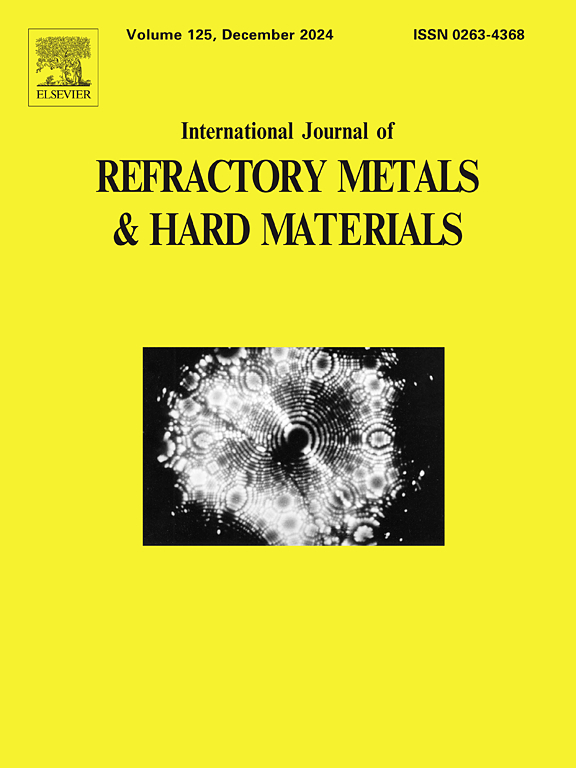Effect of selective laser melting process parameters on the microstructure and properties of WCu20 composite
IF 4.2
2区 材料科学
Q2 MATERIALS SCIENCE, MULTIDISCIPLINARY
International Journal of Refractory Metals & Hard Materials
Pub Date : 2025-02-28
DOI:10.1016/j.ijrmhm.2025.107130
引用次数: 0
Abstract
Tungsten‑copper (W![]() Cu) composites hold great promise as electrically conductive materials. However, traditional manufacturing methods, such as powder metallurgy, are unsuitable for producing dense and complex W
Cu) composites hold great promise as electrically conductive materials. However, traditional manufacturing methods, such as powder metallurgy, are unsuitable for producing dense and complex W![]() Cu components. Recently, additive manufacturing methods have been explored for preparation, but variations in process parameters significantly affect the quality of the components. Determining optimized process parameters for quality products is a challenging yet crucial issue. In this study, Selective Laser Melting (SLM) technology was used to fabricate W-Cu20wt.% composites. The effects of laser power, scanning speed, hatch spacing, and layer thickness on the density and microhardness of W
Cu components. Recently, additive manufacturing methods have been explored for preparation, but variations in process parameters significantly affect the quality of the components. Determining optimized process parameters for quality products is a challenging yet crucial issue. In this study, Selective Laser Melting (SLM) technology was used to fabricate W-Cu20wt.% composites. The effects of laser power, scanning speed, hatch spacing, and layer thickness on the density and microhardness of W![]() Cu20 composites were explored. The densification mechanism of W
Cu20 composites were explored. The densification mechanism of W![]() Cu20 composites during the SLM process was discussed. The results indicated that using a laser power of 320 W, scanning speed of 400 mm/s, layer thickness of 30 μm, and hatch spacing of 40 μm produced a dense and uniformly structured W
Cu20 composites during the SLM process was discussed. The results indicated that using a laser power of 320 W, scanning speed of 400 mm/s, layer thickness of 30 μm, and hatch spacing of 40 μm produced a dense and uniformly structured W![]() Cu20 composite successfully, with a maximum relative density of up to 98.1 %. W-Cu20 specimens with a density above 96 % exhibited hardness levels greater than 230 HV, with the optimum hardness being 256 HV.
Cu20 composite successfully, with a maximum relative density of up to 98.1 %. W-Cu20 specimens with a density above 96 % exhibited hardness levels greater than 230 HV, with the optimum hardness being 256 HV.

选择性激光熔化工艺参数对WCu20复合材料显微组织和性能的影响
钨铜(WCu)复合材料作为导电材料具有很大的前景。然而,传统的制造方法,如粉末冶金,不适合生产致密和复杂的钨铜组件。近年来,人们探索了增材制造的制备方法,但工艺参数的变化会显著影响部件的质量。为优质产品确定优化的工艺参数是一个具有挑战性但又至关重要的问题。本研究采用选择性激光熔化(SLM)技术制备W-Cu20wt。%复合材料。探讨了激光功率、扫描速度、缝隙间距和层厚对WCu20复合材料密度和显微硬度的影响。探讨了WCu20复合材料在SLM过程中的致密化机理。结果表明,在激光功率为320 W、扫描速度为400 mm/s、层厚为30 μm、缝隙间距为40 μm的条件下,制备出致密、结构均匀的WCu20复合材料,最大相对密度可达98.1%。密度在96%以上的W-Cu20试样的硬度均大于230 HV,最佳硬度为256 HV。
本文章由计算机程序翻译,如有差异,请以英文原文为准。
求助全文
约1分钟内获得全文
求助全文
来源期刊
CiteScore
7.00
自引率
13.90%
发文量
236
审稿时长
35 days
期刊介绍:
The International Journal of Refractory Metals and Hard Materials (IJRMHM) publishes original research articles concerned with all aspects of refractory metals and hard materials. Refractory metals are defined as metals with melting points higher than 1800 °C. These are tungsten, molybdenum, chromium, tantalum, niobium, hafnium, and rhenium, as well as many compounds and alloys based thereupon. Hard materials that are included in the scope of this journal are defined as materials with hardness values higher than 1000 kg/mm2, primarily intended for applications as manufacturing tools or wear resistant components in mechanical systems. Thus they encompass carbides, nitrides and borides of metals, and related compounds. A special focus of this journal is put on the family of hardmetals, which is also known as cemented tungsten carbide, and cermets which are based on titanium carbide and carbonitrides with or without a metal binder. Ceramics and superhard materials including diamond and cubic boron nitride may also be accepted provided the subject material is presented as hard materials as defined above.

 求助内容:
求助内容: 应助结果提醒方式:
应助结果提醒方式:


